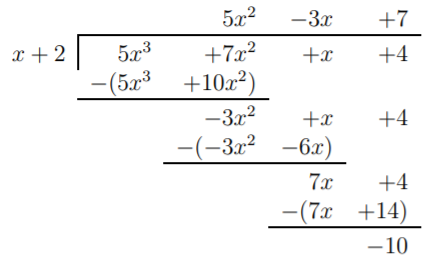8.3: Sección opcional- División sintética
- Page ID
- 117730
Al dividir un polinomio\(f(x)\) por\(g(x)=x-c\), el cálculo real de la división larga tiene muchas repeticiones innecesarias, y es posible que queramos reducir esta redundancia tanto como sea posible. De hecho, podemos extraer la parte esencial de la división larga, cuyo resultado se llama división sintética.
Nuestro primer ejemplo es la larga división de\(\dfrac{5x^3+7x^2+x+4}{x+2}\).
Solución

Aquí, el primer término\(5x^2\) del cociente se acaba de copiar del primer término del dividendo. Esto lo registramos junto con los coeficientes del dividendo\(5x^3+7x^2+x+4\) y del divisor de la\(x+2=x-(-2)\) siguiente manera:
\ [\ begin {array} {c|cccc} & 5 & 7 & 1 & 4\ qquad\ text {(dividendo)} (5 x^ {3} +7 x^ {2} +x+4)\\
-2 &&&&\ text {(divisor)} (x- (-2))\
\ hline\\
& 5 &&&\ text {(cociente)}\
\ end {array}\ nonumber\]
El primer cálculo real se realiza al multiplicar el\(5x^2\) término por\(2\), y restarlo de\(7x^2\). Esto lo registramos de la siguiente manera.

De igual manera, obtenemos el siguiente paso multiplicando el\(2x\) por\((-3)\) y restándolo de\(1x\). Por lo tanto, obtenemos:

El último paso multiplica\(7\) tiempos\(2\) y resta esto de\(4\). En definitiva, escribimos:

La respuesta se puede determinar a partir de estos coeficientes. El cociente es\(5x^2-3x+7\), y el resto lo es\(-10\).
Encuentra los siguientes cocientes vía división sintética.
- \(\dfrac{4x^3-7x^2+4x-8}{x-4}\)
- \(\dfrac{x^4-x^2+5}{x+3}\)
Solución
- Tenemos que realizar la división sintética. \ [\ begin {array} {c|cccc} & 4 & -7 & 4 & -8\\
4 && 16 & 36 & 160\\
\ hline\\
& 4 & 9 & 40 & 152\\
\ end {array}\ nonumber\]Por lo tanto tenemos
\[\dfrac{4x^3-7x^2+4x-8}{x-4}=4x^2+9x+40+\dfrac{152}{x-4} \nonumber \]
-
De igual manera, calculamos la parte (b). Tenga en cuenta que algunos de los coeficientes son ahora cero. \ [\ begin {array} {c|ccccc} & 1 &\ quad 0 & -1 &\ quad 0 & 5\\
-3 && -3 &\ quad 9 & -24 & 72\
\ hline\\
& 1 & -3 & 8 & -24 & 77\
\ end {array}\ nonumber\]Obtenemos el siguiente resultado:
\[\dfrac{x^4-x^2+5}{x+3}=x^3-3x^2+8x-24+\dfrac{77}{x+5} \nonumber \]
La división sintética solo funciona cuando se divide por un polinomio de la forma\(x-c\). No intente utilizar este método para dividir por otras formas como\(x^2+2\).


